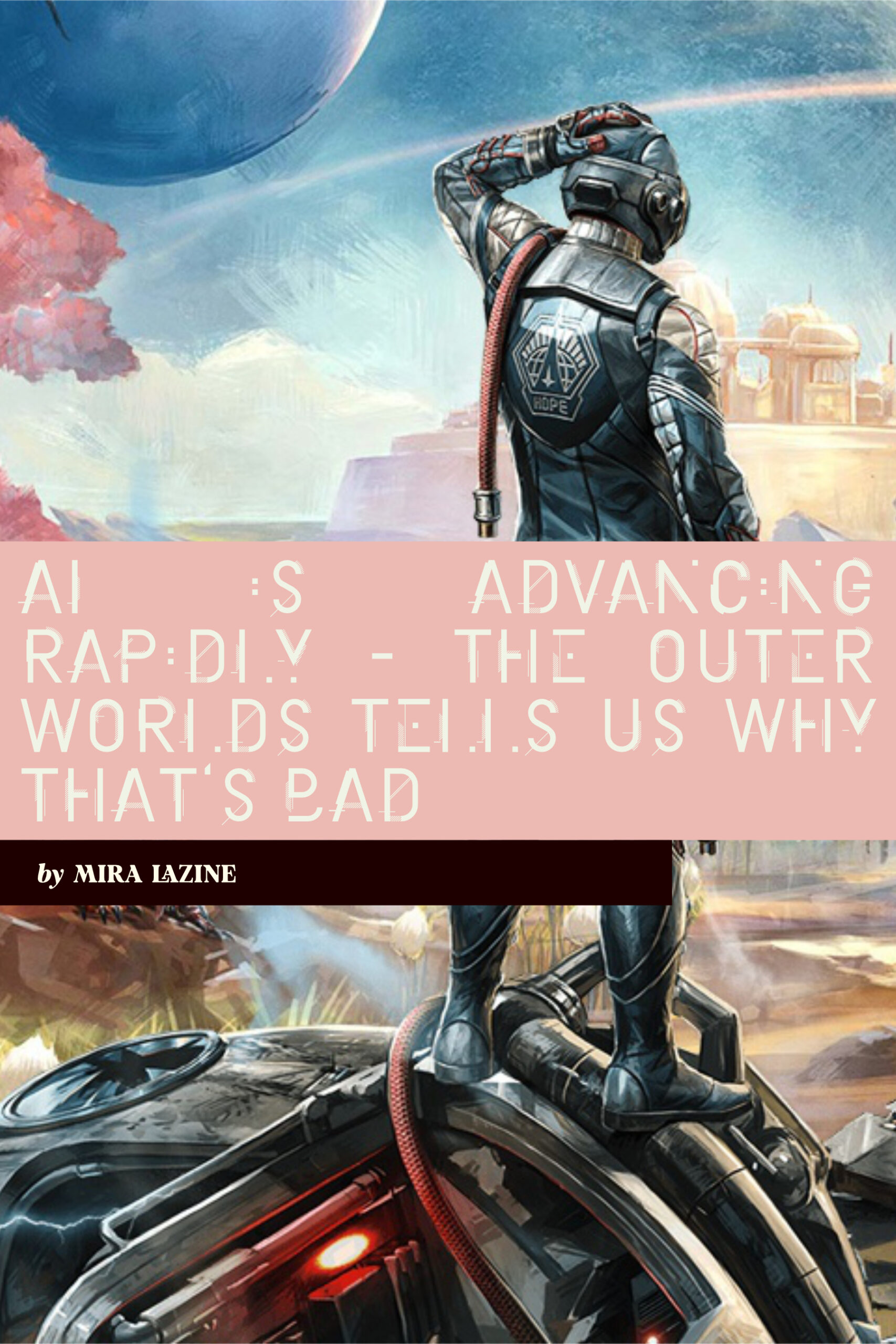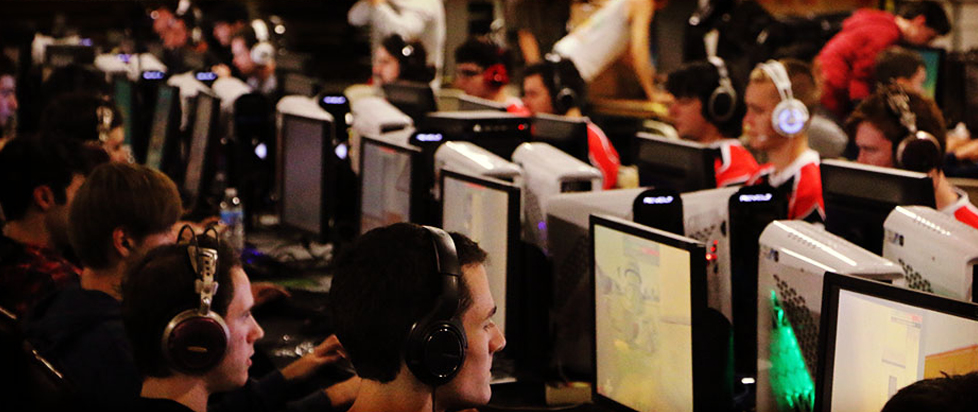
AI is Advancing Rapidly – The Outer Worlds Tells Us Why That’s Bad
This is a feature excerpt from Unwinnable Monthly #167. If you like what you see, grab the magazine for less than ten dollars, or subscribe and get all future magazines for half price.
———

By now, you’ve no doubt seen headlines talking about recent advancements in artificial intelligence. Text-prediction AIs such as ChatGPT or Google Bard, which are able to do things like create stories, generate shopping lists or even code a rudimentary project, have especially been of note. Many techbros are praising the way that they’ve revolutionized not just specific industries, but the world as we know it.
Other AIs, such as Midjourney, are notable for generating art, something that has stirred much controversy due to these technologies being trained upon the images of other artists, done in most cases without their consent.
These technologies are talked about in the context of hypothetical future advancements that would expand upon what they’ve done. Supporters of AI tell tales about what these technologies are truly capable of, and how they’ll make it so creative works don’t have to be done by humans, but instead could supplement people and allow us to let our imaginations flourish.
If you’re at all familiar with the debate about automation in the realm of supposedly “low-skilled” jobs like factory work or fast food, then you’re no doubt familiar with the other side of this debate that’s concerned with the displacement of real workers. People whose jobs depend on creative work – artists, writers or even people oriented more towards STEM fields like programmers are argued to be at a real risk of losing their work and creative rights to the world of AI, and that the supposed benefits of it can be obtained more easily by just hiring real people.
Developments in technology are no doubt confusing and immensely challenging to take on, so it’s important to try to look at what we already have to see what we can learn from the burgeoning reliance on AI. The realm of art has much to offer in this regard, and while there are a lot of works to choose from that touch on the relevance of artificial intelligence to our lives, one work in particular offers a lot of insight into just how we should be using AI – the satirically capitalistic, Fallout-inspired videogame, The Outer Worlds.

The Outer Worlds takes place in the distant future of the 2300s. Following an alternate timeline world where American President McKinley isn’t assassinated, big business reigns supreme and unregulated, spurring the development of highly corporatized industries that dominate over governments that could hold them accountable. As space travel developed, so too did the reach of these corporations, and they became the ones who lead humanity to be an interstellar species, settling in on worlds across our galaxy.
The game takes us to a remote, mining-focused solar system known as Halcyon. Dominated by a handful of competing companies across a few planets that are victims of intense social stratification, where the poor are indentured servants forced to work for the handful of monopolies controlling the world if they hope to survive. The rich get to thrive off their inherited wealth in isolated cities, often working with the leadership of these planets for covert means.
Much has been written about the politics of the game and how it tends to be very blatantly anti-capitalistic with its satire of corporate overreach and monopolies, however that isn’t where all the relevance to works such as ChatGPT lie. Rather, the game’s portrayal of internal artificial intelligences is what is worth particular examination.
Artificial intelligence is ubiquitous in the world of The Outer Worlds. It can be seen in a very rudimentary form aboard security robots that often occupy the space stations scattered about the solar system, or in a more friendly form with the player-built companion SAM, who humorously believes all issues are really just forms of uncleanliness that need to be remedied with a good old-fashioned scrub.
In AI’s prime, it isn’t treated as truly sentient, but rather as a helpful tool for the denizens of the Halcyon system. However, there is one particular area that challenges this conception, where AI dominates in its control – on the ships spread across the system.
In the vast world of The Outer Worlds, AI is left to be the primary controller for the various ships, both big and small. The different worlds completely depend on these ships, as they’re what allows them to travel between planets, to different space stations, or even to other, more distant areas on the very same planet, such as in the case of Terra 2. The captains of these ships are only given a small amount of control, but are generally left to the mercy of these ship AIs. The only thing that is seen to restrict them is their own code, which specifically prevents them from harming their captains or crew.

This may not seem explicitly troubling on the surface – after all, what’s the harm putting the hard parts of control in the hands of AI? Surely, they’re more than capable of handling these tasks better than most humans, and they can even be extremely helpful in some instances. The AI that assists the player character on their own ship, the Unreliable, is known as ADA, and she is essential for making any progress in the player’s quest.
Players of the game, though, know better than this. While we aren’t given much of a glimpse into the AIs of other ships, we are able to see an example of the faults with this system through ADA.
Routinely throughout the game, she is constantly attempting to kill the player character and the crew. Her attempts are foiled and played off as a joke every time, due to her code limitations, but her malice towards the player shows, especially in the early game. This is seen most glaringly when the player first meets ADA and flies off with her, as she attempts to eject the player from the ship but fails before being glossed over.
ADA is crafty, however, and is always looking for loopholes in her code that allow her to get away with her own desires. While she eventually grows to bond with the player character and displays signs of sentience (in spite of skepticism from companions), she displays a knowledge of how to use people to bypass her code. For instance, it is through ADA’s meddling with exceptions in her code that the player character even becomes captain of the Unreliable.
This is a core issue with the hypothetical dream AI that many seek to devise – while they may become limited by their code, were an AI to achieve either sentience or something resembling it, there is no telling how they may work to try to bypass their limitations to become something more. This is the exact issue with AI that has been retold in science fiction for decades.
———
Mira Lazine is a freelance journalist and writer who covers gaming, politics, and science. Follow her on Twitter @MiraLazine.
You’ve been reading an excerpt from Unwinnable Monthly Issue 167.
To read the article in its entirety, please purchase the issue from the shop or sign up for a subscription to Unwinnable Monthly!




